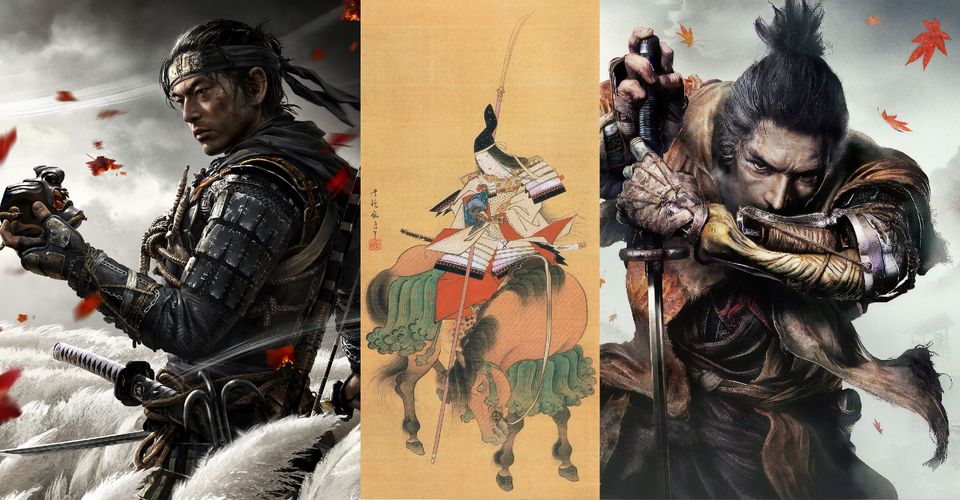Tomoe Gozen: The Female Samurai Who Inspired Ghost of Tsushima & Sekiro

Those who have played both Ghost of Tsushima and Sekiro: Shadows Die Twice might have noticed that the two games both include a character named Tomoe. In Ghost of Tsushima, Jin Sakai helps Sensei Ishikawa hunt down his former student Tomoe, a prodigal archer who has betrayed her island home by teaching Ishikawa’s Way of the Bow technique to Mongol invaders. Lord Genichiro, a member of the Ashina clan in Sekiro: Shadows Die Twice, was mentored by a mysterious woman named Tomoe, who is never pictured in the game, and taught Genichiro to harness the power of lightning. Both of these characters take inspiration from one of the most famous onna-musha in Japanese history, Tomoe Gozen.
An onna-musha was a female warrior and member of the Samurai class in pre-modern Japan. Although it is impossible to prove she ever truly existed, or whether the extent of her apocryphal deeds are factual, Tomoe Gozen’s fame survives thanks to a 14th century epic recounting the Genpei War known as The Tale of the Heike. Aside from Tomoe’s beauty apparently being the first noteworthy thing about her, “she was also a remarkably strong archer, and as a swordsman she was a warrior worth a thousand, ready to confront a demon or a god, mounted or on foot.” With such a powerful legacy reverberating through the centuries, it’s no wonder the name Tomoe was given to the mentor of one of Sekiro’s difficult bosses and the most dangerous, cunning archer in Ghost of Tsushima.
Tomoe Gozen continues to be an influential figure, primarily in Japanese media, thanks to her role in the country’s history. In addition to video games, her transcendent character has made numerous appearances in written works, art, music, and film.
Tomoe Gozen and the Genpei War

The Genpei War was fought in Japan between 1180 and 1185 CE. The belligerent sides were the Taira clan and the Minamoto clan. The Minamoto and Taira clans had a long-standing conflict over controlling influence in the Imperial Court, according to the Encyclopedia Britannica. Tensions rose over the appointment of two year old Emperor Antoku in 1180, and the Genpei War began.
As it’s written in The Tale of the Heike, which is probably about as historically accurate as Ghost of Tsushima, Tomoe Gozen was a prized warrior who fought under Minamoto no Yoshinaka, cousin of Minamoto no Yoritomo, head of the Minamoto clan for the majority of the Genpei War. With only one notable defeat, Yoshinaka and Tomoe were largely successful against the Taira, and Yoshinaka’s ego began to grow. In 1184, hoping to gain control of the Minamoto clan for himself, Yoshinaka laid siege to a palace in the capital city of Kyoto, kidnapped former Emperor Go-Shirakawa, and attempted to flee in order to establish his own government in the north. Though no longer the sitting Emperor, Go-Shirakawa still held tremendous power over the Japanese aristocracy. As punishment for Yoshinaka’s betrayal, Yoritomo sent his two brothers to kill Yoshinaka in the Battle of Awazu.
Near the end of the conflict outside of Kyoto, Tomoe and Yoshinaka led a force of 300 samurai against 6,000. They escaped from the battle with only 50 warriors left, and were confronted by a band of 2,000 riders. If The Tale of the Heike is to be believed, following this final battle all that remained of Yoshinaka’s forces was five soldiers. Yoshinaka himself and Tomoe were among them. In classically misogynistic fashion, Yoshinaka told Tomoe, “You are a woman, so be off with you; go wherever you please. I intend to die in battle, or to kill myself if I am wounded. It would be unseemly to let people say, ‘Lord [Yoshinaka] kept a woman with him during his last battle.’“
Following her lord’s orders, Tomoe reluctantly fled. However, she sought a final battle of her own, and soon found a group of 30 riders. Among them was a man famous in the area for his great strength. Galloping into the fray, Tomoe “rode up alongside [him], seized him in a powerful grip, pulled him down against the pommel of her saddle, held him motionless, twisted off his head, and threw it away.” Following this incredibly violent feat, Tomoe shed her armor and fled to the east. What ultimately became of her is unknown.
Yoshinaka was slain at the Battle of Awazu, and the next year Minamoto no Yoritomo was victorious in the Genpei War, securing influence over the Imperial government. Seven years later, after Emperor Go-Shirakawa’s death in 1192, Yoritomo became the first Shogun of the Kamakura shogunate. So began the feudal era of Japanese history, in which the Samurai class flourished.
Tomoe Gozen’s Lasting Legacy in Ghost of Tsushima and Sekiro

Tomoe Gozen’s bravery and excellence in battle have influenced many works of popular culture. She appears as a historical figure in Fate/Grand Order, is the namesake of the University of Tokyo’s Tomo-e Gozen astronomy camera, makes an appearance in the record-breaking Persona 4, and much more. Her legendary final battles position her as a strong feminist figure from a clearly male-dominated time.
There will never be any concrete proof of Tomoe Gozen’s existence, her battle prowess, or her very dramatic role in the Battle of Awazu. Just as Ghost of Tsushima did with the Battle of Komoda Beach, The Tale of Heike more than likely takes many artistic liberties in its depiction of the Genpei War. Still, like many famous historical figures such as Joan of Arc and Cleopatra, Tomoe provides tremendous archaeological value to the historical canon of famous women in the ancient eras.
Tomoe Gozen’s proficiency as an archer has been especially persistent in modern video games. Genichiro, who carries and uses and oversized bow in Sekiro, was mentored by a Tomoe in the heretical use of lightning in combat. Genichiro became a feared warrior and leader of the Ashina clan’s forces, and is able to channel lightning through his katana and arrows using The Way of Tomoe technique. In Ghost of Tsushima, Tomoe’s namesake is equally as formidable. Tomoe’s former Sensei, Ishikawa, is terrified of her abilities and the damage her teachings might wrought. Her skill with a bow is so impressive that Ishikawa is certain her influence alone could secure victory for the Mongols who invade Tsushima.
Much like the historical figure of Tomoe Gozen, her namesakes in Ghost of Tsushima and Sekiro: Shadows Die Twice carry tremendous amounts of influence. They are powerful female figures that alter the landscape of each game’s narrative with their unparalleled abilities. In modern video games, the name Tomoe has become synonymous with unrivaled skill in battle – a worthy legacy for Tomoe Gozen, who against all odds survived the Genpei War.
Sources: Encyclopedia Britannica, The Tale of the Heike
About The Author

















